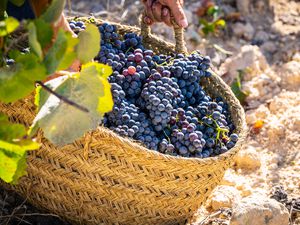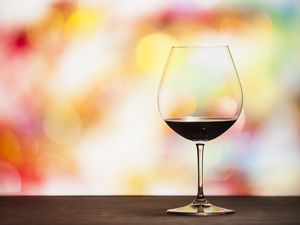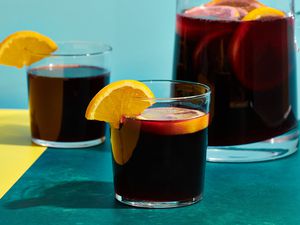
JGI /Jamie Grill / Getty Images
Sweet red wines are often sought after as either an introduction to wine or as a "transitionary wine" from whites to reds. Though red wines that are firmly planted in the sweet category are considerably harder to find than sweet white wines, they are available.
In the wine world, sweet is the antithesis of dry. The majority of the world's red wines are made in a dry style. These have lower levels of residual sugar (RS) and often a higher tannin content, which adds considerably to the perception of a dry taste profile.
When looking for a sweet red wine, you want the opposite, but it can be hard to know if a red is sweet or dry. There are a few things that you can look for that will tell you if you're holding a sweeter red wine.
Sweet or Fruity
In general, when it comes to sweet wines it is easy to confuse sweet with "fruity." While a wine's sweetness is perceived by the taste buds on the tip of the tongue, a wine's fruitiness is largely an aromatic perception.
Keep in mind that you can physically taste only five sensations: sweet, sour, salty, bitter, and savory (umami). Yet, you can smell thousands of scents, so a wine's fruitiness is the combined efforts of taste and aroma.
Tannins will also tame the wine's fruitiness. If a wine is overly tannic (or dry), it will bind the fruit on the palate and mask many of the aromas and perceptions of fruit. That is why we tend to notice more fruits in low-tannin wines. Many of these wines are also sweeter because they naturally have more leftover sugars.

Indicators of a Sweet Wine
Wines can be loosely categorized as sweet, off-dry (semi-sweet), or dry. Typically, the amount of residual sugar in a wine will determine a wine's level of sweetness.
Remember that the fermentation process takes the naturally occurring sugars in the grape and converts them into alcohol with the help of yeast. When fermentation is stopped before all of the sugars are converted, the alcohol content is lower and the wine is sweeter.
With this in mind, the amount of alcohol in a wine can clue you into its residual sugar. All you need to do is look at the alcohol by volume (ABV) on the wine label. Wines generally fall somewhere between 5.5 percent and 23 percent ABV.
In table wines, the lower the alcohol content, the higher the residual sugar content and the sweeter the wine. There are exceptions to this, but it is a good general rule to go by. This is one reason why you'll often see German Rieslings with alcohol levels in the range of 8 to 12 percent ABV, with considerably higher levels of residual sugar.
Sweet Red Wine Categories
The most famous sweet red wines fall into the dessert wine category. You'll want to look in that section while shopping. You can look for wine labels that fall into a few categories:
- Germany's Dornfelder grape is often made into a lighter-styled, slightly sweet version. While it is not overly exported, it can certainly be found in U.S. markets. It is worth a try if you are searching for a sweeter style of red wine.
- Italy's Lambrusco is a slightly sweet, slightly sparkling, and inexpensive red wine that has wooed wine lovers the world over for years. It is intended to be consumed young and is readily available in most markets.
- In Australia, sweet red wines are appropriately dubbed "stickies." These can use a range of grapes and many producers have built them into their success stories.
- The fortified wine known as port will also do its best to fill a sweet tooth's expectations.
Specific Sweet Red Wines
Again, most sweet red wines will fall under the "dessert wine" designation. Here are a few top-notch red dessert wines that are definitely worth hunting down.
- Banfi's Rosa Regale: This bright red wine from Italy's well-loved Piedmont region has a devoted following. It is a red sparkling wine that is sweet and subtle with the lush flavors of ripe raspberry and juicy strawberry. Consider giving this wine a run with chocolate-based desserts, fresh fruit, or pecan pie.
- Rosenblum Cellars Late Harvest Zinfandel: Zinfandel tends to naturally put more fruit toward the front of the profile. When combined with the concentrated sugars of the late harvest, this Rosenbloom wine throws some serious sweet to the palate. Expect some rich toffee character combined with dark cherry, raspberry, and a touch of fig all under the veil of sweet spice.
- Inniskillin Winery Cabernet Franc: Inniskillin is Canada's premier ice wine producer. As such, they have devoted themselves to making ice wine out of Cabernet Franc. To say that it showcases sweet red berry fruit—mainly strawberry and raspberry—would be a severe understatement. It is a virtual explosion of concentrated fruit carried out with an elegance that is unsurpassed.
Remember to Check the Label
The next time you find yourself searching for a sweet red wine, remember a key label clue is the alcohol content. For sweet red wines, it's one of two extremes in alcohol content.
For wines like the famous sweet ports, you will look for a high level of alcohol. For others, such as a German Reisling or Lambrusco, seek out wines in the 8 to 11 percent ABV range. Any higher and you're looking at a drier red wine.














